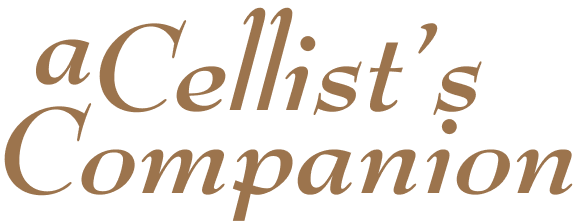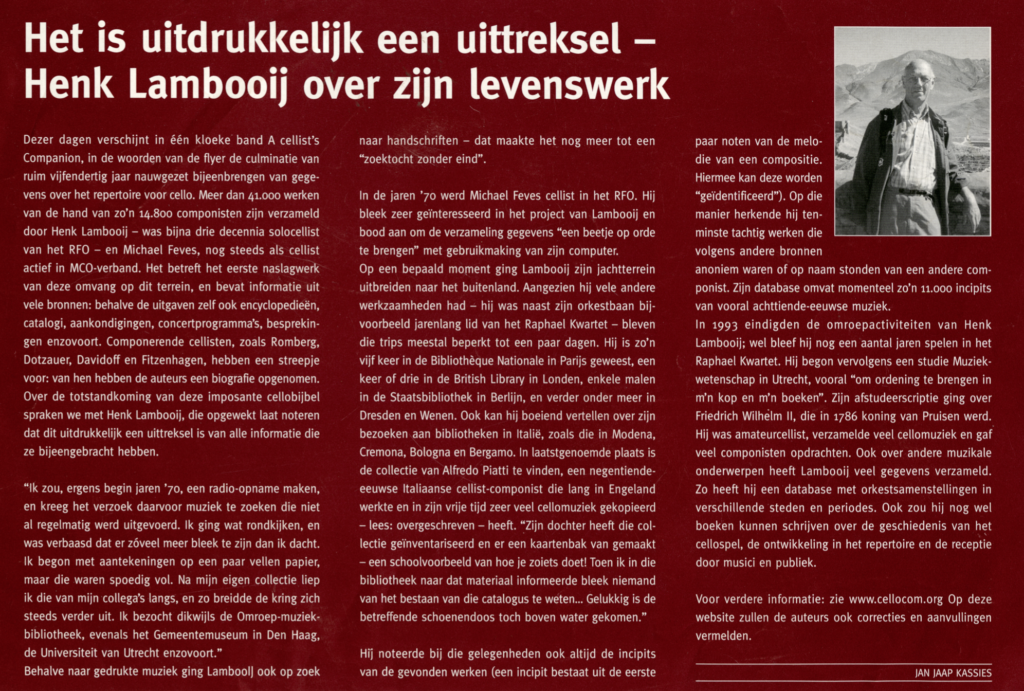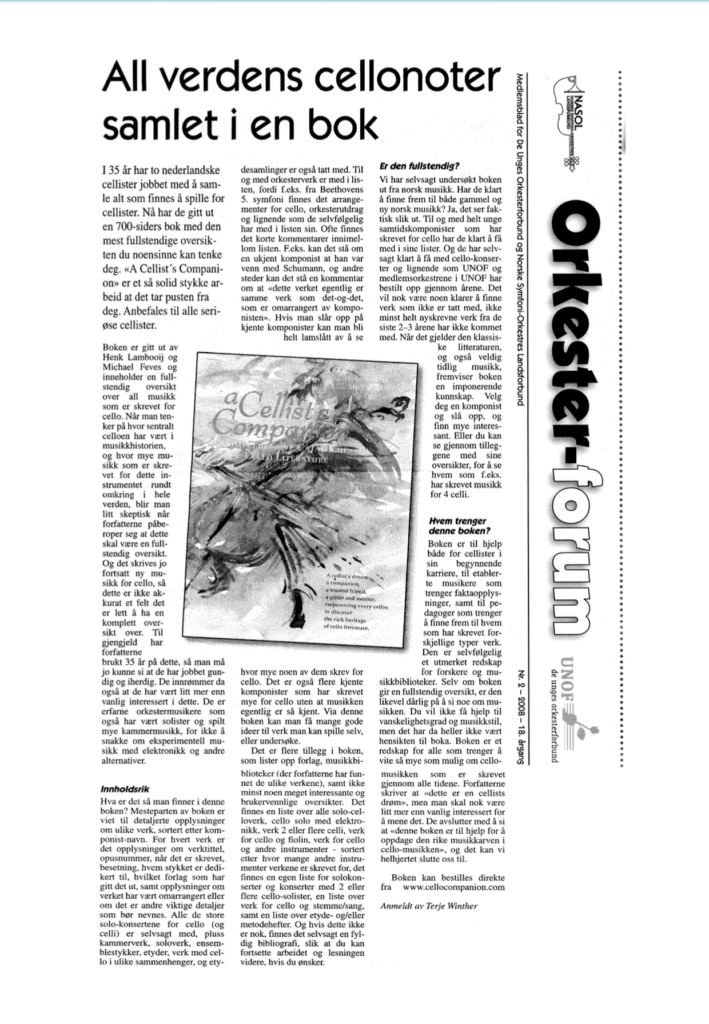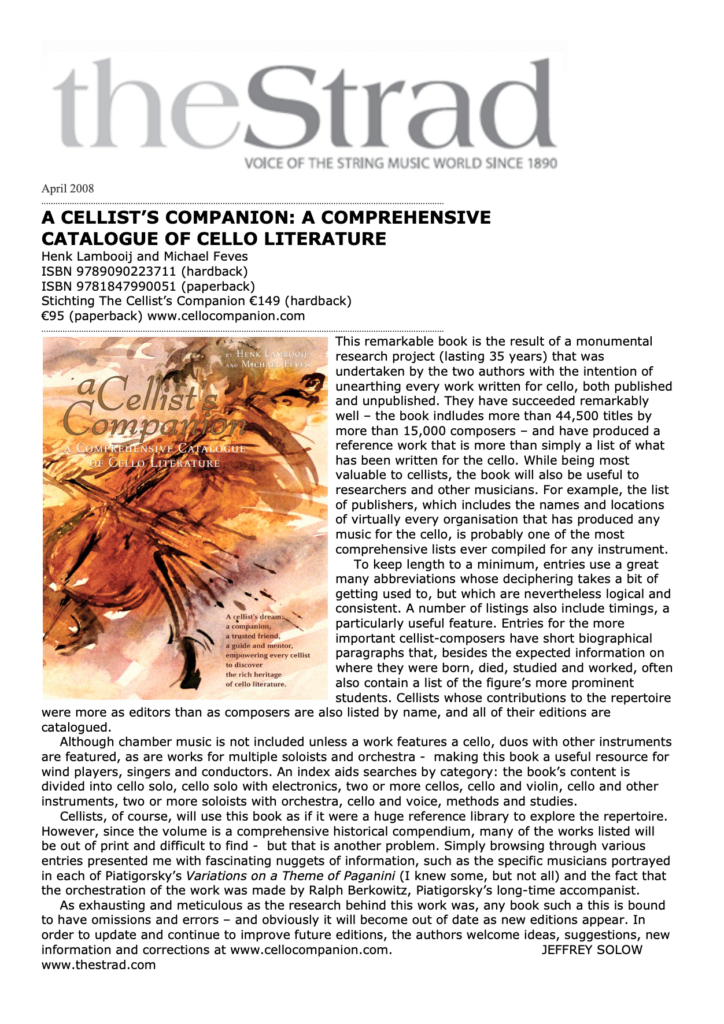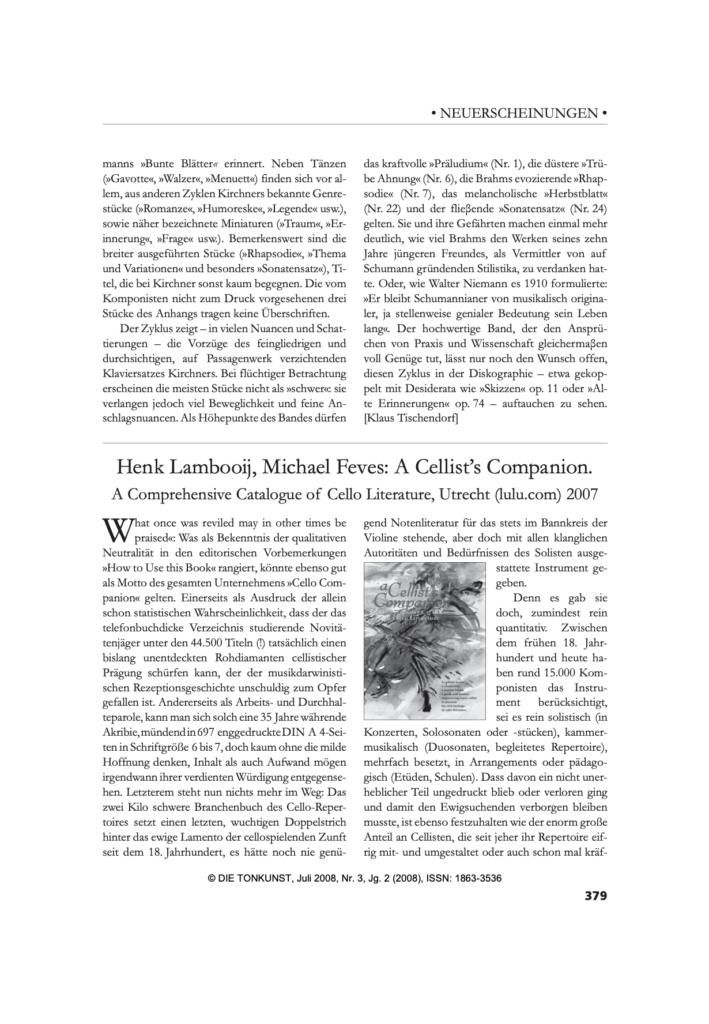Reviews
Jan Jaap Kassies, MCO NiewuZ no. 4, Dec. 2006 english
It is expressly an excerpt
Henk Lambooij about his life’s work
A Cellist’s Companion will soon be released in one volume – in the words of the flyer – the culmination of more than thirty-five years of painstaking collection of data on cello repertoire. Over 41,000 works by some 14,800 composers have been collected by Henk Lambooij – who was solo cellist at the RFO for almost three decades – and Michael Feves, who is still active as a cellist in the MCO context. It is the first reference work of this size in this field, and contains information from many sources: in addition to the editions themselves, encyclopaedias, catalogues, announcements, concert programs, reviews, etc. Composing cellists such as Romberg, Dotzauer, Davidoff and Fitzenhagen have an advantage: the authors have included a biography with them. We spoke to Henk Lambooij about the creation of this impressive cello bible, who cheerfully notes that this is expressly an extract of all the information they have collected.
“Sometime in the early 1970s, I was going to make a radio recording, and was asked to find music that was not regularly performed. When I looked around, I was surprised that there was so much more than I thought. I started with notes on a few sheets of paper, but they were soon full. After my own collection, I went through those of my colleagues, and the circle grew wider and wider. I often visited the Omroep music library, as well as the Gemeentemuseum in The Hague, the University of Utrecht and so on.” In addition to printed music, Lambooij also went in search of manuscripts – which made it even more of an “endless quest.”
In the 1970s, [sic 1980] Michael Feves became a cellist at the RFO. He turned out to be very interested in Lambooij’s project and offered to “sort it out a bit” using his computer. At a certain point, Lambooij started to expand his hunting grounds abroad. Since he had many other activities – in addition to his orchestra job, for example, he was a member of the Raphael Quartet for many years – those trips were usually limited to a few days. He has been to the Bibliotheque Nationale in Paris about five times, three times to the British Library in London, several times to the Staatsbibliothek in Berlin, and also to Dresden and Vienna, among others. He can tell fascinating stories about his visits to libraries in Italy, such as those in Modena, Cremona, Bologna and Bergamo. In the latter place you can find the collection of Alfredo Piatti, a nineteenth-century Italian cellist-composer who worked in England for a long time and copied – read: transcribed – a great deal of cello music in his spare time. “His daughter made an inventory of the collection and turned it into a card catalog – a textbook example of how to do such a thing! When I inquired about it in the library, no one seemed to know about the existence of the catalog… Fortunately, the shoe box in question has surfaced after all.”
On those occasions he also always noted the incipits of the works found (an incipit consists of the first few notes of the melody of a composition. This allows it to be “identified”). In this way, he recognized at least eighty works that, according to other sources, were anonymous or were listed as the work of another composer. His database currently comprises some 11,000 incipits, mainly of eighteenth-century music.
Henk Lambooij’s broadcasting activities ended in 1993. He did continue to play in the Raphael Quartet for a number of years. He then decided to study musicology in Utrecht, mainly “to bring order to my head and my books”. His graduation thesis was about Friedrich Wilhelm II, who became King of Prussia in 1786. Friedrich Wilhelm was an amateur cellist, collected a lot of cello music and commissioned many composers. Lambooij has also collected data on other musical subjects. For example, he has a database with the size and instrumentation of orchestras in different cities and periods. He could also write books about the history of cello playing, the development in the repertoire and the reception by musicians and audiences. For further information: see www.cellocom.org [sic www.cellocompanion.com]. The authors will also post corrections and additions on this website.
Excerpts from a review by Stephen Mantz, University of Colorado at Boulder.
in: Notes, Second Series, Vol. 66, No. 1 (Sep., 2009), pp. 98-100 (3 pages). Published by: Music Library Association
https://www.jstor.org/stable/40539435
“…It is a remarkable survey, a true celebration of violoncello literature by two accomplished cellists. The reference book includes arrangements and original compositions, published works in print and out of print, works that are lost, and manuscripts. It is arranged alphabetically by the last name of the composer or arranger, augmented by a classified index at the back of the book that provides access by medium of performance: cello solo, cello with electronics, two or more cellos, cello and violin, cello and other instruments, two or more soloists, cello and voice, and methods and studies. Not included in the index are works for cello and piano and for cello and orchestra, “because practically every composer wrote for these combinations” (p. 657). This seems to be a concession to saving space….
…Each name entry includes the date and place of birth (and death, where appropriate). Cellist-composer entries may also include a short biographical paragraph. Under each name entry are the titles, arranged first by opus or thematic catalog number, then alphabetically for those works without such numbering. Each entry may include the work’s key, instrumentation, year of composition, duration, and the name of the person to whom it was dedicated (if any). Publication information follows for as many editions as are known: place, date, publisher, and publisher number. If the publication information is not known, or the work is not published, the authors provide the source of information or the library where the title can be located. Occasionally, one will see titles without a source; these usually include the notation “not verified.”
A nice feature of A Cellist’s Companion is that it includes collections of violoncello music, so the text can also be used as a finding aid for these works. Unfortunately, not all of the collections included are cross-referenced. Another noteworthy feature is the inclusion of arrangements. Many guides to repertoire concentrate solely on original compositions written for the specified instrument. That is not the case here, where arrangements occupy an equal footing alongside original compositions. Arrangements are entered in two places. A brief entry appears under the title for the original work, followed by the term “arrangements,” the name of the arranger and a short title of the arrangement. The full entry appears under the name of the arranger, with a reference back to the composer entry….
…the book is a useful tool for cellists and researchers. It collocates a great deal of data, providing a unique survey of the violoncello literature. This work should be viewed not as a final achievement, but as a remarkable foundation upon which others can continue to build.
Review Bernhard Helpenstein, Das Orchester, 7 Aug. 2008
Review Bernhard Helpenstein, Das Orchester, 7 Aug. 2008
…Wenn man so durch den Katalog blättert, macht man erstaunliche Entdeckungen: Wer hätte gedacht, dass Sebastian Lee – der nur noch durch seine Etüden bekannt scheint – mit mehr als fünf Spalten großzügiger bedacht wird als z. B. Vivaldi (knapp dreieinhalb Spalten) oder das Robert Bockmühl, der Schumann bei seinem Konzert bereit, fleißig für das Cello komponierte und arrangierte und mit rund viereinhalb Spalten ein umfangreiches Œuvre vorzuweisen hat. Einmal zur Hand genommen legt man diesen Wälzer so schnell nicht aus der Hand und blättert und stöbert und bekommt große Lust, Musikalienhandlungen, Bibliotheken und Archive aufzusuchen und den eigen Notenbesand zu erweiteren.
Mit diesem Buch, Das Aufnahme in die Bibliothek jedes ambitionierten Cellisten finden sollte, is die Aussage, für das Cello gebe es zu wenig Literatur,endg¨¨ltig ins Reich der Legende zu verweisen.
…When you leaf through the catalogue, you make astonishing discoveries: who would have thought that Sebastian Lee – who only seems to be known for his etudes – would be given more than five columns than [for instance] Vivaldi (almost three and a half columns) or that of Robert Bockmühl, who [assisted] Schumann[with] his concerto, diligently composed and arranged for the cello and, with around four and a half columns, has an extensive oeuvre to show. Once you have picked up this [catalog], you will not be able to put it down, and will leaf through and rummage, and [acquire a] great desire to visit music shops, libraries and archives and expand your own stock of music.
With this book, which should be included in the library of every ambitious cellist, the statement that there is too little literature for the cello is finally relegated to the realm of legend.
Jeffrey Solow, The Strad April, 2008
This remarkable book is the result of a monumental research project (lasting 35 years) that was undertaken by the two authors with the intention of unearthing every work written for cello, both published and unpublished. They have succeeded remarkably well … and have produced a reference work that is more than simply a list of what has been written for the cello.
… the list of publishers, which includes the names and locations of virtually every organization that has produced any music for the cello, is probably one of the most comprehensive lists ever compiled for any instrument.
…Although chamber music is not included unless a work features a cello, duos with other instruments are featured, as are works for multiple soloists and orchestra – making this book a useful resource for wind players, singers and conductors
.
…Cellists, of course, will use this book as if it were a huge reference library to explore the repertoire. However, since the volume is a comprehensive historical compendium, many of the works listed will be out of print and difficult to find – but that is another problem. Simply browsing through various entries presented me with fascinating nuggets of information, such as the specific musicians portrayed in each of Piatigorsky’s Variations on a Theme of Paganini (I knew some, but not all) and the fact that the orchestration of the work was made by Ralph Berkowitz, Piatigorsky’s long-time accompanist
Graham Pellettieri, Strings Aug. 7, 2008
…Covering more than 300 years of published music, out-of-print editions, unpublished manuscripts, titles mentioned only in reference books, and self-published works, this volume is truly encyclopedic, and would be a valuable resource for cellists who desire to know about all the cello music that is available.
